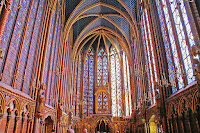
Architect Ludwig Mies van der Rohe (1886-1969) once proclaimed, “God is in the details.” Mies’s international style of architecture was clean and simple. He virtually invented the sleek glass-and-steel buildings that define mid-twentieth century modern architecture. His structures epitomized minimalism before it became a cliché. At first glance, these buildings appear stark and unadorned, but Mies’s work is distinguished from lesser imitations by his insistence on refined details and perfect implementation. To appreciate a building by Mies van der Rohe one needs to look at the details. His buildings come alive in the elegant manner in which the pieces of a window mullion are assembled, in the grace with which a stairway effortlessly unites different levels, in the perfect resolution of structural connections. The Farnsworth house (Plano, Illinois 1951) is one of the best examples of his work.
Perception of objects in the real world progresses from the general to the particular. We see the color of objects before we get a clear understanding of shape or form. Then, once the form comes into focus, we begin to notice texture, line, and structural organization. This is the level of perception where details become important.
Why do architects get so concerned about details? Why did Mies insist “God is in the details”? Because he knew that details separate the sophisticated from the amateur and the real from the fake. We live in buildings on the level of the things that we see, touch, and use; that is: the details. The purpose of a building is established by its overall shape, but details add dimension and richness.
Even the most ordinary of spaces are lifted to a higher plane by good details. For example, a simple patio changes character depending on the fine points of design. Is it made of concrete, gray and unadorned? That would be ordinary and not worth noticing. Imagine how much richer the experience would be if the concrete is textured or colored. Attention to detail changes the quality of architectural spaces, just as spices and herbs enhance the flavor of food. Take this a step further. Imagine that patio with sun-dappled bricks, a bubbling fountain, and a vine-covered colonnade surrounding it. The experience of that patio grows into something completely different. Details imbue it with charm and it becomes a delight for the senses. Attention to detail is essential for a complete architectural experience.
Unfortunately, most buildings ignore the importance of details. In spite of this, people search for places that more completely satisfy the need for beauty. That is one reason we travel. We crave the richness lacking in everyday life. We travel in search of adventure, history, and -- not least -- architecture. We appreciate buildings with tiled courtyards and crenellated towers. We love to stumble across modest cafes with charming architecture, artisanship, and interesting materials. Such places make us feel good. This feeling -- a sense of rightness about a place and our enjoyment of being in it -- owes much to detail.
Sometimes richness of detail accrues over time: things come together gradually to imbue a place with charm and grace. But it doesn’t have to happen by chance, nor is the patina of age a prerequisite. Good architecture can intentionally integrate details that are right with each other and an appropriate part of the whole. That is what architecture is really all about: the purposeful creation of places that make us feel good. Places that give us the feeling of belonging to something beneficent. In architecture, the details bestow this feeling.
Credits:
Farnsworth House exterior and stairs: Jack E. Boucher.
Barcelona Pavilion interior: vicens.
Palladio Garden, Rovigo, Italy: Marcock.
Balboa Park arcade, San Diego, California: M. Knorr.
Baroque column capital: Michail Jungierek.



























